Elva (car manufacturer)
Elva was a sports and racing car manufacturing company based in Bexhill, then Hastings and Rye, East Sussex, United Kingdom. The company was founded in 1955 by Frank G. Nichols. The name comes from the French phrase elle va ("she goes").[1]
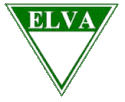 | |
| British Sports and racing car manufacturer | |
| Industry | Automobiles |
| Founded | 1955 |
| Founder | Frank G. Nichols |
| Defunct | 1968 |
| Headquarters | Bexhill, Sussex , |
| Products | Elva racing cars Elva Courier |
| Website | www |
Racing cars
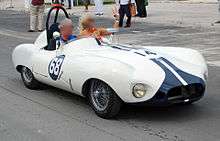
Frank Nichols's intention was to build a low-cost sports/racing car, and a series of models were produced between 1954 and 1959. The original model, based on the CSM car built nearby in Hastings by Mike Chapman, used Standard Ten front suspension rather than Ford swing axles, and a Ford Anglia rear axle with an overhead-valve-conversion of a Ford 10 engine. About 25 were made.[1] While awaiting delivery of the CSM, Nichols finished second in a handicap race at Goodwood on 27 March 1954, driving a Lotus.[2] "From racing a Ford-engined CSM sports car in 1954, just for fun but nevertheless with great success, Frank Nichols has become a component manufacturer. The intermediate stage was concerned with the design of a special head, tried in the CSM and the introduction of the Elva car which was raced with success in 1955."[3] The cylinder head for the 1,172 cc Ford engine, devised by Malcolm Witts and Harry Weslake, featured overhead inlet valves.[4]
On 22 May 1955 Robbie Mackenzie-Low climbed Prescott in the sports Elva to set the class record at 51.14 sec.[5] Mackenzie-Low also won the Bodiam Hill Climb outright at the end of the season.[6]
The 1956 Elva MK II works prototype, registered KDY 68, was fitted with a Falcon all-enveloping fibreglass bodyshell.[7] Nichols developed the Elva Mk II from lessons learnt in racing the prototype: "That car was driven in 1956 races by Archie Scott Brown, Stuart Lewis-Evans and others." The Elva Mk II appeared in 1957: "Main differences from the Mark I are in the use of a De Dion rear axle as on the prototype, but with new location, inboard rear brakes, lengthened wheelbase, and lighter chassis frame."[8] The car was offered as standard with 1,100 cc Coventry-Climax engine. This went through various changes up to the Mark IV of 1958.
Carl Haas, from Chicago, was Elva agent in the midwest of the United States from the mid-1950s through the 1960s. In 1958 he was invited to England to drive an Elva in the Tourist Trophy at Goodwood, where he finished twelfth overall. With the Mark IV: "The major change is an all-new independent rear suspension utilizing low-pivot swing axles. The body is entirely new with close attention to aerodynamics and a reduced frontal area."[9] At the Sebring 12 Hours sports car race in 1959 the No. 48 Elva Mark IV driven by Frank Baptista, Art Tweedale and Charley Wallace finished first in Class G,[10] and 19th overall.[11]
On 21 June 1959, Arthur Tweedale and Bob Davis won the Marlboro Six Hour Endurance Race in Maryland driving the No. 37 Elva Mk IV.[12] Arthur Tweedale repeated the win in the Marlboro Six Hours in 1960. Teamed with Ed Costley he covered 337.75 miles in an Elva Mk V sports car.[13] This was the final iteration of the Elva front-engined sports racing car. The last Mk V chassis won a number of important races in the midwest driven by Dick Buedingen, including the 1961 Elkhart Lake 500 teamed with Carl Haas. At this time Elva Cars Limited was operating from premises at Sedlescombe Road North, Hastings, Sussex, England.[14]
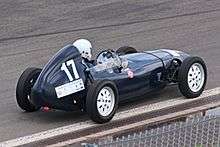
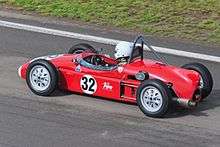
Elva produced a single-seater car for Formula Junior events, the FJ 100, initially supplied with a front-mounted B.M.C. 'A' series engine in a tubular steel chassis. "Elva Cars, Ltd., new Formula Junior powered by an untuned BMC 'A' Series 948cc engine. The price of this 970 lb. car is $2,725 in England. Wheelbase: 84", tread: 48", brake lining area: 163" sq. The 15" wheels are cast magnesium. Independent suspension front and rear with transverse wishbones, coil springs, and telescopic shock absorbers. The car is 12 feet, four inches long."[15] Bill de Selincourt won a race at Cadours, France, in an Elva-B.M.C. FJ on September 6, 1959.[16] Nichols switched to a two-stroke DKW engine supplied by Gerhard Mitter.[7] In 1959 Peter Arundell won the John Davy Trophy at the Boxing Day Brands Hatch meeting driving an Elva-D.K.W.[17] "Orders poured in for the Elva but when the 1960 season commenced Lotus and Cooper had things under control and disillusioned Elva owners watched the rear-engined car disappearing round corners, knowing they had backed the wrong horse." [18] Sporadic success continued for Elva in the early part of that year, with Jim Hall winning at Sebring and Loyer at Montlhéry.[19]
Elva produced a rear-engined FJ car, with B.M.C. engine, at the end of the 1960 season.[20] Chuck Dietrich finished third at Silverstone in the BRDC British Empire Trophy race on 1 October.[21] In 1961 "an entirely new and rather experimental Elva-Ford" FJ-car debuted at Goodwood, making fastest lap, driven by Chris Meek.[22]
After financial problems caused by the failure of the US distributor, Frank Nichols started a new company in Rye, Sussex in 1961 to continue building racing cars. The Elva Mk VI rear-engined sports car, with 1,100 cc Coventry Climax power, made its competition debut at Brands Hatch on Boxing Day, 1961, driven by Chris Ashmore, finishing second to the three-litre Ferrari of Graham Hill.[23] The car was designed by Keith Marsden.[24]
On 8 September 1963, Bill Wuesthoff and Augie Pabst won the Road America 500, round seven of the United States Road Racing Championship, at Elkhart Lake, Wisconsin driving an Elva Mk.7-Porsche. "The Elva-Porsche is based on the Mark VII Elva, but redesigned aft of the front section to take the 1,700 cc Porsche air-cooled flat-four unit and its horizontal cooling fan."[25]
Edgar Barth won the opening round of the European Hill Climb Championship on 7 June 1964, at Rossfeld in southern Germany in an Elva-Porsche flat-eight sports car.[26] The cars were placed throughout the seven-round series with Herbert Muller winning at the final round at Sierre Montana Crans in Switzerland on 30 August 1964.[27]
Around 1964-1966 Elva made a very successful series of Mk8 sports racers mostly with 1.8 litre BMW engines (modified from the 1.6 litre by Nerus) and some with 1.15 litre Holbay-Ford engines. The Mk8 had a longer wheelbase and wider track compared to the Mk7, which was known for difficult handling due to a 70-30 weight bias to the rear.[28] Following the success of the McLaren in sportscar racing, Elva became involved in producing cars for sale to customers:
"Later a tie-up with Elva and the Trojan Group was arranged and they took over the manufacture of the McLaren sports/racer, under the name McLaren-Elva-Oldsmobile." [29]
At the 1966 Racing Car Show, held in London in January, Elva exhibited two sports racing cars – the McLaren-Elva Mk.II V8 and the Elva-BMW Mk. VIIIS. The McLaren-Elva was offered with the option of Oldsmobile, Chevrolet or Ford V8 engines. The Elva-BMW Mk. VIIIS was fitted with a rear-mounted BMW two-litre four-cylinder OHC engine.[30]
Luki Botha campaigned an Elva-Porsche in southern Africa from 1966.
Elva Courier
| Elva Courier | |
|---|---|
| Overview | |
| Manufacturer | Elva |
| Production | 1958-1969 500 approx made |
| Body and chassis | |
| Class | sports car |
| Body style | 2-door convertible 2-door coupe |
| Dimensions | |
| Wheelbase | 90 in (2,286 mm)[31] |
| Length | 154 in (3,912 mm)[31] |
| Width | 60 in (1,524 mm)[31] |
The main road car, introduced in 1958, was called the Courier and went through a series of developments throughout the existence of the company. Initially all the cars were exported, home market sales not starting until 1960.[32] Mark Donohue had his first racing successes in an Elva Courier winning the SCCA F Prod Championship in 1960 and the SCCA E Prod Championship in 1961.
The Mk 1 used a 1500 cc MGA or Riley 1.5 litre engine in a ladder chassis with Elva designed independent front suspension. The engine was set well back in the chassis to help weight distribution, which produced good handling but encroached on the cockpit making the car a little cramped. The chassis carried lightweight 2-seater open glassfibre bodywork. It was produced as a complete car for the US and European market and available in kit form for the UK market. After about 50 cars were made it was upgraded to the Mk II which was the same car but fitted with a proprietary curved glass windscreen, replacing the original flat-glass split type, and the larger 1600 cc MGA engine. Approximately 400 of the Mk I and II were made.[33]
The rights to the Elva Courier were acquired by Trojan in 1962,[34] and production moved to the main Trojan factory in Purley Way, Croydon, Surrey. Competition Press announced: "Elva Courier manufacturing rights have been sold to Lambretta-Trojan in England. F-Jr Elva and Mark IV sports cars will continue to be built by Frank Nichols as in the past."[35]
With the Trojan takeover the Mk III was introduced in 1962 and was sold as a complete car. On the home market a complete car cost £965 or the kit version £716. The chassis was now a box frame moulded into the body. Triumph rack and pinion steering and front suspension was standardised. A closed coupé body was also available with either a reverse slope Ford Anglia-type rear window or a fastback. In autumn 1962: "Elva Courier Mk IV was shown at London Show. New coupe has all-independent suspension, fiberglass body, MG engine. Mk III Couriers were also shown. Though previously equipped with MG-A engines, new versions will be equipped with 1800cc MG-B engine."[36] Later the Ford Cortina GT unit was available. The final version, the fixed head coupé Mk IV T type used Lotus twin-cam engines with the body modified to give more interior room. It could be had with all independent suspension and four wheel disc brakes. 210 were made.[33]
Ken Sheppard Customised Sports Cars of Shenley, Hertfordshire acquired the Elva Courier from Trojan in 1965 but production ended in 1968.
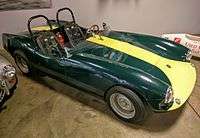 1959 Elva Courier Mark 1
1959 Elva Courier Mark 1 1960 Elva Courier
1960 Elva Courier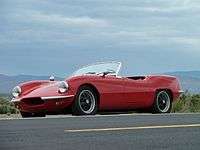 Elva Courier front/side view
Elva Courier front/side view
GT160
| GT160 | |
|---|---|
_ret.jpg) | |
| Overview | |
| Manufacturer | Elva |
| Production | 1964 |
| Designer | Trevor Fiore |
| Body and chassis | |
| Class | Sports car |
| Dimensions | |
| Wheelbase | 93 in (2,362 mm)[31] |
| Length | 150 in (3,810 mm)[31] |
| Width | 60 in (1,524 mm)[31] |
| Curb weight | 559 kg (1232 lbs) |
There was also a GT160 which never got beyond production of three prototypes. It used a BMW dry sump engine of 2 litre capacity with bodywork styled by Englishman Trevor Frost (also known as Trevor Fiore, and who also designed the Trident) and made by Carrozzeria Fissore of Turin.[37] It weighed 11 long hundredweight (559 kg) and had 185 bhp (138 kW; 188 PS) so would have had very impressive performance but was deemed too costly to put into series production. The car was shown at the London Motor Show in 1964.[38] One of the cars was purchased by Richard Wrottesley and entered in the 1965 24 Hours of Le Mans. Co-driven by Tony Lanfranchi, the car retired early in the race.

Other companies
There was another Elva car company that lasted for one year, 1907, and was based in Paris, France.
See also
- Stuart Lewis-Evans
- Archie Scott Brown
- Archie Butterworth
- Tony Lanfranchi
- Trojan (racing team)
References
- Georgano, G.N., N. (2000). Beaulieu Encyclopedia of the Automobile. London: HMSO. ISBN 1-57958-293-1.
- Motor Sport, May 1954, Pages 230, 242.
- West Coast Sports Car Journal, August 1956, Page 24.
- G.N. Georgano, The Complete encyclopedia of motorcars, 1885 to the present, Dutton 1971, Page 276.
- Motor Sport, June 1955, Page 298. See photograph Page 308.
- Motor Sport, December 1957, Page 718, gives 1955 result.
- Automobile Quarterly, Volume 35, Issue 4, Page 39.
- Motor Racing, March 1957, Page 79.
- Competition Press, Vol.II-No.2, 31 January 1959, Page 6. See also: Sports Car Graphic, December 1959, Pages 28-31.
- Cleveland Plain Dealer, 23 March 1959, Page 33.
- Competition Press, Vol.II-No.6, 28 March 1959, Page 1.
- Competition Press, 11 July 1959, Page 2.
- The Washington Post, Times Herald, 6 June 1960, Page A19.
- The Observer's Book of Automobiles, Eighth Edition, Frederick Warne & Co. Ltd., 1962, Pages 98-99.
- Competition Press, June 27, 1959, Page 5.
- Motor Sport, January 1960, Page 18.
- Motor Sport, February 1960, Page 109. See also cover photograph.
- Motor Sport, April 1963, Pages 240-241, 244.
- Motor Sport, February 1961, Page 114.
- Motor Racing, November 1960, Page 389.
- Motor Sport, November 1960, Page 958.
- Autosport, 26 May 1961, Page 690.
- Motor Sport, February 1962, pictured on cover also in centre spread.
- Road & Track, February 1962, Pages 46-47. See also: Sports Car Graphic, April 1962, Pages 46-49, 70-71.
- The Autocar, 20 September 1963, Pages 541-542.
- Motor Sport, July 1964, Page 570.
- Motor Sport, January 1965, Page 8.
- Autosport, 13 May 2010, Page 78.
- Motor Sport, July 1966, Page 600.
- Racing Car Show 1966, Official Catalogue and Guide, Pages 69-70.
- Culshaw; Horrobin (1974). Complete Catalogue of British Cars. London: Macmillan. ISBN 0-333-16689-2.
- Robson, Graham (2006). A-Z British Cars 1945-1980. Devon, UK: Herridge & Sons. ISBN 0-9541063-9-3.
- Sedgwick, Michael; Gillies (1993). A-Z of cars 1945-1970. UK: Bay View Books. ISBN 1-870979-39-7.
- "Trojan Lambretta expansion", Automobile Engineer: 135, 1962
- Competition Press, Vol.8-No.5, 10 March 1962, Page 7.
- Competition Press, Vol.9-No.10, 24 November 1962, Page 4.
- "'Elle va-she goes!'". The World of Automobiles. 5. Columbia House. 1974. pp. 597–598.
- Motor Sport, October 1964, Page 801.